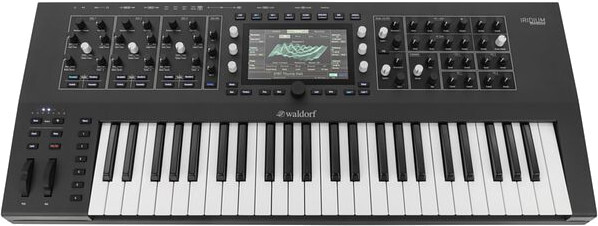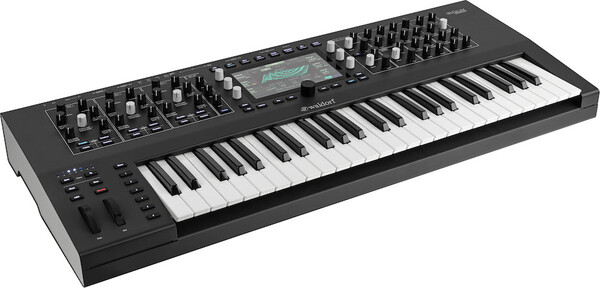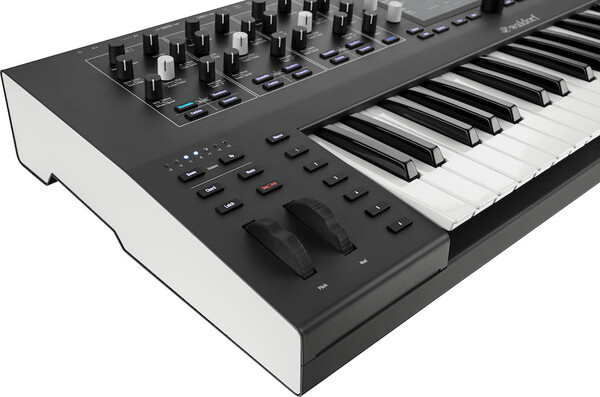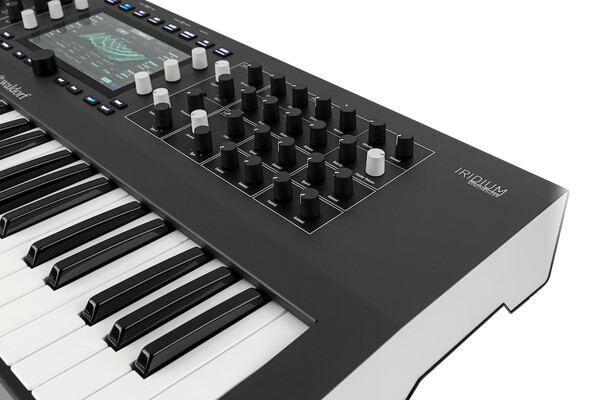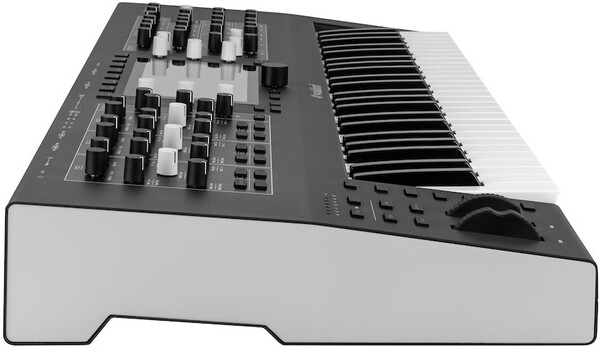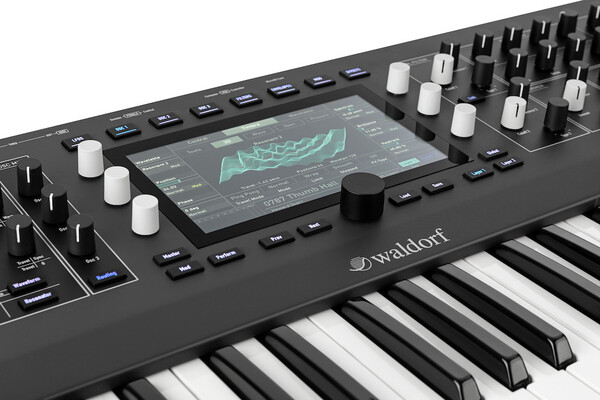Waldorf Iridium Keyboard
Synthesizer
EUR 2619.00
MSRP: EUR 2991.00
MSRP: EUR 2991.00
Incl. VAT, free shipping in Germany
| Product # | 236785 |
| Brand | Waldorf |
| Category | Synthesizers | Brand Category | Waldorf - Synthesizers |
| Release date | June 2022 |
| Availability |  Will be ordered for you as quick as possible Will be ordered for you as quick as possible |
Unit: 1 piece(s)
Description
Tremendous tonal changes flow freely when playing the Iridium Keyboard live since polyphonic aftertouch is transmitted individually for each note played. Performers can conceivably play and hold down any number of keys simultaneously, subsequently moving each finger individually. In other words, individual keys are affected by the pressure applied by each finger, thereby creating, for instance, individual data streams for modulation purposes, whereas with monophonic (Channel) aftertouch all notes played will respond in the same way. With a powerful Mod Matrix offering 40 independent modulation assignments, each with individual settings for Source, Amount, and Destination, Iridium Keyboard comes with powerful modulation options — just like the Iridium desktop synthesizer namesake. Notably, Iridium Keyboard is also capable of processing MPE (MIDI Polyphonic Expression) data, duly making multiple parameters of different notes separately controllable to effectively enable it to behave more like an acoustic instrument in terms of spontaneous, polyphonic sound control.
Clearly, the 851 mm (W) x 355 mm (D) x 110 mm (H) physical dimensions of Iridium Keyboard has resulted in some marked differences to the original Iridium desktop design, with a one-knob-per-function control approach afforded by its naturally expanded front panel, albeit aided still by its industrial-grade highly-responsive touchscreen display to provide an interactive overview of the Mode page selected (via associated LFOS, OSC 1, OSC 2, OSC 3, FILTERS, MOD, and EFFECTS buttons), parameter changes, and additional information. Indeed, Iridium Keyboard also incorporates six freely-programmable Macro buttons adjacent to the Pitch and Mod (modulation) wheels with which users can define functions from a wide range of features for additional performance control, combining to further enhance its performance pedigree.
Iridium Keyboard — with its industrial design bearing the high-class hallmarks of Axel Hartmann — takes pride of place in the high-quality German synthesizer developer’s distinctive family tree as another direct descendent of the legendary PPG Wave synthesizer series that made their mark throughout the Eighties by bringing the distinctive sound of wavetable synthesis to the musical masses. Musically, though, the Iridium Keyboard — like its Iridium desktop synthesizer sibling — brings much more to the production table than its acclaimed ancestor, featuring five different synthesis models for each of its three oscillators (OSC 1, OSC 2, and OSC 3): Wavetable — a table consisting of single-cycle waveforms; Waveform (virtual analogue) — a standard oscillator model to create typical analogue waveforms; Particle (sampling and granular sampling) — allowing for extensive manipulation of sample-based sounds; Resonator — manipulates multi- samples from the internal (2GB) sample flash memory or noise via an exciter and various spectral parameters that can be modulated, matchless for generating awe- inspiring animated sounds and drones, which can, for example, easily be integrated into a Eurorack modular synthesizer environment via the Iridium Keyboard’s integrated control voltage connections (CV In1, CV In2, CV In3, and CV In4); and Kernels — effectively enabling one oscillator to become up to six sub-oscillators that can be interlinked through FM at audio rate and arranged in user-definable constellations.
Clearly, the 851 mm (W) x 355 mm (D) x 110 mm (H) physical dimensions of Iridium Keyboard has resulted in some marked differences to the original Iridium desktop design, with a one-knob-per-function control approach afforded by its naturally expanded front panel, albeit aided still by its industrial-grade highly-responsive touchscreen display to provide an interactive overview of the Mode page selected (via associated LFOS, OSC 1, OSC 2, OSC 3, FILTERS, MOD, and EFFECTS buttons), parameter changes, and additional information. Indeed, Iridium Keyboard also incorporates six freely-programmable Macro buttons adjacent to the Pitch and Mod (modulation) wheels with which users can define functions from a wide range of features for additional performance control, combining to further enhance its performance pedigree.
Iridium Keyboard — with its industrial design bearing the high-class hallmarks of Axel Hartmann — takes pride of place in the high-quality German synthesizer developer’s distinctive family tree as another direct descendent of the legendary PPG Wave synthesizer series that made their mark throughout the Eighties by bringing the distinctive sound of wavetable synthesis to the musical masses. Musically, though, the Iridium Keyboard — like its Iridium desktop synthesizer sibling — brings much more to the production table than its acclaimed ancestor, featuring five different synthesis models for each of its three oscillators (OSC 1, OSC 2, and OSC 3): Wavetable — a table consisting of single-cycle waveforms; Waveform (virtual analogue) — a standard oscillator model to create typical analogue waveforms; Particle (sampling and granular sampling) — allowing for extensive manipulation of sample-based sounds; Resonator — manipulates multi- samples from the internal (2GB) sample flash memory or noise via an exciter and various spectral parameters that can be modulated, matchless for generating awe- inspiring animated sounds and drones, which can, for example, easily be integrated into a Eurorack modular synthesizer environment via the Iridium Keyboard’s integrated control voltage connections (CV In1, CV In2, CV In3, and CV In4); and Kernels — effectively enabling one oscillator to become up to six sub-oscillators that can be interlinked through FM at audio rate and arranged in user-definable constellations.
Attributes
Key attributes
| ||||||||||||||||
Product Dimensions
| ||||||||||||||||
Synthesizer attributes
| ||||||||||||||||
Product Details
| ||||||||||||||||
Dimension
|
Properties
- 16-voice polyphony, duo-timbral
- Compatible with the Waldorf Quantum synth engine
- 49 light weighted keys with velocity and polyphonic aftertouch (Fatar TP/8S)
- six free programmable macro keys
- 3 digital oscillators per voice
- synthesis algorithms: Wavetable, Classical Waveforms, Granular Sampler, Resonator; Kernel
- Two digital stereo filters in different modes and configurations
- 6 LFOs in Poly and Global mode
- 6 Envelopes
- Master Effect Rack with 5 slots
- Master Compressor
- Modulation Matrix with 40 slots
- Loading and saving of presets via USB and SD card
- 2 GB internal memory
- Import possibility of Nave presets
- Connectors: Main output 2x 6.3mm jack, Line input 2x 6.3mm jack
- Headphone output 6.3mm jack stereo
- USB Host connector
- Midi IN/Out/Thru
- 4 CV inputs for connecting EuroRack modules, CV Clock I/O, CV Gate, CV Start
- Weight: 14.000kg
- Height: 110mm
- Width: 851mm
- Depth: 355mm
- Compatible with the Waldorf Quantum synth engine
- 49 light weighted keys with velocity and polyphonic aftertouch (Fatar TP/8S)
- six free programmable macro keys
- 3 digital oscillators per voice
- synthesis algorithms: Wavetable, Classical Waveforms, Granular Sampler, Resonator; Kernel
- Two digital stereo filters in different modes and configurations
- 6 LFOs in Poly and Global mode
- 6 Envelopes
- Master Effect Rack with 5 slots
- Master Compressor
- Modulation Matrix with 40 slots
- Loading and saving of presets via USB and SD card
- 2 GB internal memory
- Import possibility of Nave presets
- Connectors: Main output 2x 6.3mm jack, Line input 2x 6.3mm jack
- Headphone output 6.3mm jack stereo
- USB Host connector
- Midi IN/Out/Thru
- 4 CV inputs for connecting EuroRack modules, CV Clock I/O, CV Gate, CV Start
- Weight: 14.000kg
- Height: 110mm
- Width: 851mm
- Depth: 355mm
Videos (2)
Report incorrect data about this product

